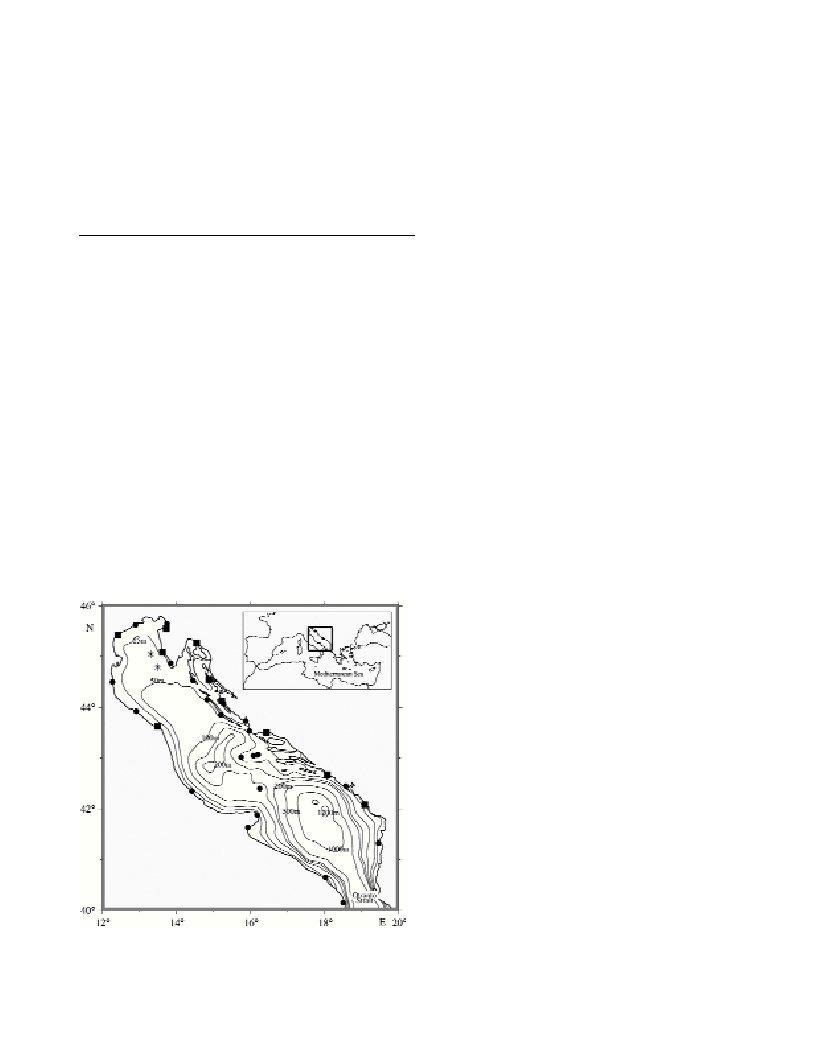Rapp. Comm. int. Mer Médit., 37,2004
108
TIDAL DYNAMICS OF THE ADRIATIC SEA USING HIGH RESOLUTION 3D FINITE ELEMENT MODEL
AND IN SITU OBSERVATIONS
Ivica Janekovic* and Milivoj Kuzmic
Center for Marine and Environmental Research, Rudjer, Boskovic Institute, Bijenicka c 54, 10002 Zagreb, Croatia - * ivica@irb.hr
Abstract
In the present work we explore the impact of assimilating local tide gauge on the quality of predicting seven major Adriatic tidal harmonics.
To that end we compute optimal tidal open boundary conditions for a 3D high-resolution finite element model using inverse modeling
technique. Derived harmonic constants from original time series from 10 tide gauges are assimilated and the results are analyzed with
literature available values. RMSE for observed and modeled amplitudes are less than 1cm. The model output is also successfully validated
with current data, not used in the assimilation.
Keywords: Tides, numerical model, data assimilation, Adriatic Sea
Introduction
The need for accurate tidal correction of altimetric signal has
revived interest in tidal modelling of marginal seas. In case of the
Adriatic, estimation of tidal dynamics is primarily dependent to
determination of boundary conditions along one open boundary.
Complexity of ?ows in the basin resulting from the elaborate coastline
and bottom topography makes the problem interesting and
challenging. In a recent modelling study [1] the Adriatic tides were
addressed as a part of the larger, Mediterranean solution. Similar 3D
model was used [2] to simulate co-oscillation of four Adriatic
harmonics while data assimilation technique, for the first time, was
used in [3] to study major Adriatic harmonics (M2 and K1). The goal
of the present study is to explore further dynamics for seven major
tidal harmonics by assimilating data from 10 local tidal gauges.
Data
One type of used data are original tide gauge time series for 10
stations (squares on Figure 1). The data were collected simultaneous
with record length of approx. two months (28/2/1982 – 30/4/1982).
Tidal analyses were done for 38 harmonics and only seven of the most
energetic ones (M2, S2, K2, N2, O1, P1 and K1) were used in the
study. The other data source is harmonic constants compiled and
verified from available literature (dots on Figure 1). The current data
used in verification were obtained with 6 Aanderaa RCM-4 current
meters deployed at 2 mooring stations in the Northern Adriatic (stars
in Figure 1). Useful deployment period was about one month, from
December 2
nd
1986 till January 4
th
1987.
Fig. 1. Adriatic Sea bathymetry map with stations used in the study.
Method and models
Although the Adriatic Sea has only one short open boundary along
the Straits of Otranto this appears to be a difficult one as there has
been no published data on the bottom pressure covering the boundary.
We used 3D finite element linear model and its inverse in order to
obtain open boundary conditions for each tidal harmonic separately.
Inversion is based on the best fit of the model to the observations, in
the least squares sense. Three-dimensional forward model [4] is a
finite element model based on the 3D non-linear shallow water
equations. The finite element grid consists of 23055 nodes and 37200
elements with the nodal distances varying from about 500m in coastal
areas up to 44 km in the largest triangle (deep parts of domain). With
this mesh we have been able to include in our simulations 77 major
islands and recognise realistic topography and lateral geometry better
than in any previous Adriatic tidal model. The model is forced only by
time varying sea level boundary conditions along 40
o
N resulting from
the output of data assimilative models.
Results and conclusions
Using the mentioned method we were able to obtain open boundary
values for seven major harmonics in dynamically consistent way. The
two most energetic harmonics M2 and K1 obtained in previous study
[3] showed good agreement with values in this study (although a
different inverse models and technique were used). Obtained open
boundary amplitude structure shows small values (<2 cm) for
harmonics other than 3 major ones (M2, S2 and K1). By assimilating
higher amplitude values at the northern part of domain (where tidal
signal is stronger) we succeeded to reproduce small values at the open
boundary. The phase structure is characterised by 2 groups: diurnal
with values between 40
o
and 55
o
, and semidiurnal with phases
ranging between 90
o
and 110
o
. For semi-diurnal harmonics basin-
wide solutions show well known cyclonically rotating amphidromic
system; diurnal solutions exhibit narrow phase sweep (20
o
to 25
o
) in
cross-basin direction (northeast to southwest) with amplitude rise
along the central axis (southeast to northwest). Comparison of
modelled amplitudes with those obtained via harmonic analyses
generated small RMSE (M2 ~0.8cm, S2 ~0.2cm, K2 ~0.4cm, N2
~0.3cm, K1 ~0.5cm, P1 ~0.2cm, O1 ~0.3cm).
Verification of model with measured currents produced rather
agreeable result. At two locations and at three depths the model was
able to reproduce both the major and minor semi-axes in close
agreement with measured data (not used in data assimilation
procedure). RMSE for major (M2 ~1.4cm/s, S2 ~1.2cm/s, K1
~0.9cm/s) and minor semi-axis (M2 ~0.9cm/s, S2 ~0.5cm/s, K1
~0.3cm/s) are close to observed RMSE (1.8cm/s and 1.5cm/s for
major and minor semi-axis).
References
1-Tsimplis M. N., Proctor R. and Flather R. A., 1995. A two-dimensional
tidal model for the Mediterranean Sea. J. Geophys. Res., 100C: 16223-
16239.
2-Cushman-Roisin B. and Naimie C. E., 2002. A 3D finite-element
model of the Adriatic tides. J. Marine Sys., 37: 279-297.
3-Janekovic I., Kuzmic M and Bobanovic J., 2003. The Adriatic Sea M2
and K1 tides by 3D model and data assimilation. Estuar. Coast. Shelf Sci.,
57: 873-885.
4-Lynch D. R., Justin T. C. IP., Naimie C. E. & Werner F. E., 1996.
Comprehensive coastal circulation model with application to the Gulf of
Maine. Cont. Shelf Res., 16: 875-906.

